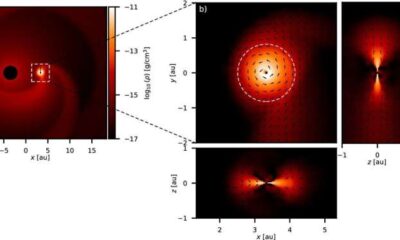Science
Genetic Breakthrough Could Triple Wheat Yields, Say Scientists

Recent research from the University of Maryland suggests that advances in genetic understanding could significantly enhance wheat production. The discovery centers on a particular type of wheat known as mutant MOV (multi-ovary) wheat, which has the potential to produce up to three grains per floret, as opposed to the single grain typically generated by ordinary wheat plants.
Unlocking Genetic Mechanisms for Higher Yields
In standard wheat plants, each floret in the seed head develops a single ovary that produces one grain. The mutant MOV wheat, however, exhibits a unique characteristic: certain florets can have multiple ovaries. Until now, the genetic basis for this trait remained elusive. The research team conducted a comprehensive DNA analysis of the MOV wheat, comparing it to conventional bread wheat. Their investigation revealed that a previously dormant gene, known as WUSCHEL-D1 (WUS-D1), is activated in MOV wheat.
This gene plays a critical role in the formation of additional female reproductive structures, including ovaries and pistils. By activating WUS-D1 in traditional wheat varieties, scientists believe they can significantly increase grain production.
Assoc. Prof. Vijay Tiwari, a co-author of the study, emphasized the implications of this breakthrough, stating, “Pinpointing the genetic basis of this trait offers a path for breeders to incorporate it into new wheat varieties, potentially increasing the number of grains per spike and overall yield.”
Future of Wheat Breeding
The findings are documented in a paper published in the Proceedings of the National Academy of Sciences. With the aid of advanced gene editing technologies, researchers are now positioned to enhance this trait in cultivated wheat. The potential to triple grain yields could have far-reaching effects on global food security, particularly in regions facing challenges of population growth and agricultural sustainability.
This research not only marks a significant advancement in agricultural science but also opens new avenues for breeding high-yielding crops that could meet the growing demand for food worldwide. As scientists continue to explore the genetic underpinnings of wheat production, the hope is that these innovations will translate into practical solutions for farmers around the globe.
-

 Science1 month ago
Science1 month agoOhio State Study Uncovers Brain Connectivity and Function Links
-

 Politics2 months ago
Politics2 months agoHamas Chief Stresses Disarmament Tied to Occupation’s End
-

 Science1 month ago
Science1 month agoUniversity of Hawaiʻi Joins $25.6M AI Project for Disaster Monitoring
-

 Entertainment1 month ago
Entertainment1 month agoMegan Thee Stallion Exposes Alleged Online Attack by Bots
-

 Science4 weeks ago
Science4 weeks agoALMA Discovers Companion Orbiting Giant Star π 1 Gruis
-

 Science2 months ago
Science2 months agoResearchers Challenge 200-Year-Old Physics Principle with Atomic Engines
-

 Entertainment1 month ago
Entertainment1 month agoPaloma Elsesser Shines at LA Event with Iconic Slicked-Back Bun
-

 World1 month ago
World1 month agoFDA Unveils Plan to Cut Drug Prices and Boost Biosimilars
-

 Top Stories2 months ago
Top Stories2 months agoFederal Agents Detain Driver in Addison; Protests Erupt Immediately
-

 Business1 month ago
Business1 month agoMotley Fool Wealth Management Reduces Medtronic Holdings by 14.7%
-

 Entertainment1 month ago
Entertainment1 month agoBeloved Artist and Community Leader Gloria Rosencrants Passes Away
-

 Science2 months ago
Science2 months agoInnovator Captures Light at 2 Billion Frames Per Second








